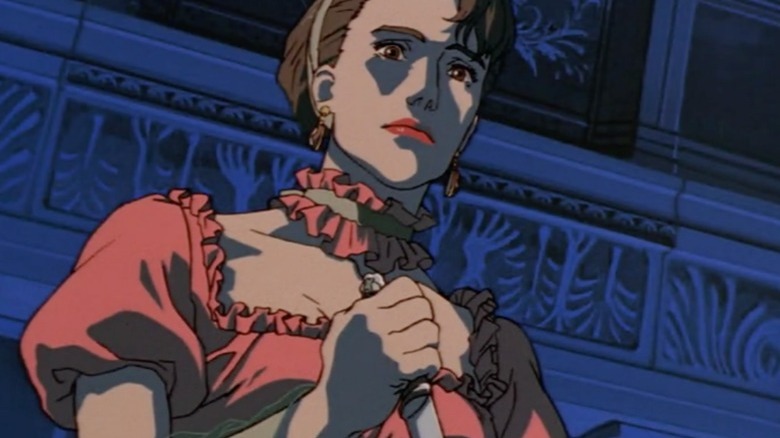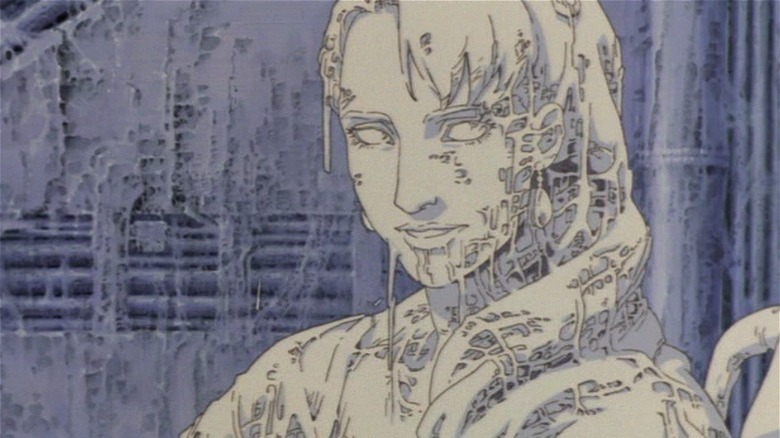The Sci-Fi Short Satoshi Kon Wrote Before Perfect Blue Or Paprika Has An Akira Connection
Prolific animator and manga-ka Satoshi Kon had a sustained interest in exploring the nature of reality, particularly the way in which humans interact with their perception of what's real. This thematic fascination encapsulates Kon's body of work, which deal with characters oscillating between objective reality and constructed ones, with the line between the two getting increasingly blurred as the narrative progresses.
Kon's most famous work, "Perfect Blue," which is considered his magnum opus, exclusively revolves around a J-pop star-turned-actor losing their grip on reality while crumbling under the weight of worldly perception, voyeurism, and fractured identity. Similar themes are also peppered throughout "Paprika" and "Millennium Actress" — films that further hone Kon's vision of crafting realistic worlds that harbor something sinister beneath a pretty facade. However, Kon first forayed into these themes as early as 1995, when he collaborated with "Akira" animator Kōji Morimoto on "Magnetic Rose."
Kon's "Magnetic Rose" still remains a key entry point into the mind of the director-animator, who expertly used skewed perspectives, internally-torn characters, and breathtaking visuals to weave cautionary tales about the fragility of existence. Although this animated short lacks the polished artistry of Kon's later works, it exemplifies his eye for capturing poetry in motion.
A mind-bending space horror from the makers of Akira
Katsuhiro Otomo, creator of the original 1982 manga series "Akira" and its 1988 animated adaptation of the same name, went on to pen numerous manga short stories with a futuristic setting. In 1995, Otomo served as executive producer to "Memories," an anthology film that featured three of his short stories, namely "Magnetic Rose," "Stink Bomb," and "Canon Fodder." While Otomo directed "Canon Fodder" and "Stink Bomb" was spearheaded by Tensai Okamura, Morimoto donned the director's cap for "Magnetic Rose." So, how does Kon fit into the equation? Well, he wrote the screenplay for "Magnetic Rose," thereby transforming Otomo's work into a gripping, layered space opera that boasts stunning imagery and complex metaphors.
Although Otomo's "Memories" is a stellar anthology, "Magnetic Rose" is easily the best short among the trio. Visually and emotionally riveting, "Magnetic Rose" echoes sci-fi tropes of films such as Andrei Tarkovsky's "Solaris" and Ridley Scott's "Alien," but manages to tell an original, unique story about memories and how they haunt us. Both Morimoto and Kon approach the story with startling creative ingenuity, utilizing subtle visual cues to unravel key character aspects. Although the credit for the narrative complexity of "Magnetic Rose" belongs to Otomo, Kon's screenplay reinvigorates the oft-used sci-fi tropes in the tale, and prevents it from becoming stale or completely predictable.
The ending of "Magnetic Rose" is not a happy one: Kon utilizes this resolution to visually explore the themes of revenge and betrayal, while attempting to dissect the psychology of a woman jilted by a lover. "Magnetic Rose" is a story about memories, and how they warp and re-contextualize the past with our inability to let go. With AI in the mix, it is impossible for ghosts of the past to die a natural death.
How Kon elevates the subject matter of Magnetic Rose
"Magnetic Rose" opens with a space freight ship, The Corona, receiving an SOS distress signal from a seemingly abandoned space station in the middle of nowhere. Two engineers, Heintz and Miguel, venture out to the source of the signal to help out potential survivors, but what they discover instead is a Victorian-era mansion with decaying interiors, whose hallways are haunted by realistic holograms of a long-deceased opera singer named Eva Friedel. The two engineers realize the gravity of the situation a little too late after the place hounds them into succumbing to their deepest desires by preying on their memories.
Over the course of time, it is revealed that Eva, whose tale mirrors the tragedy of Giacomo Puccini's "Madame Butterfly," is a prisoner of her own memories even after death. Instead of seeking freedom, the holograms of Eva, which are controlled by a sentient robot that contains her consciousness, entrap men into a web of memories, both real and fabricated.
In all honesty, the basic premise of "Magnetic Rose" is nothing original. Similar themes have been tackled with considerable nuance and greater skill in several films. However, Kon infuses the story with something innately special: firstly, the animation medium allows the story's surreal aspects to blossom beautifully, and secondly, the use of sonic and visual cues to layer and reveal the story of the central antagonist intensifies the climax of the tale. Moreover, Kon gives us a glimpse of the kind of filmmaking he has always been interested in, wherein reality and fiction intersect, becoming indistinguishable to evoke horror. The tragedy of "Magnetic Rose" lies in the fact that Eva is not attempting to alter the past, but trying to alter her memory of the past by manipulating the present.
Exploring a vortex of death and suffering
In Kon's short, Heintz and Miguel are victims of their innermost desires, which makes it easier for them to be lulled deeper inside the ghost ship. While Miguel desires to return to the numerous women he desires, Heintz secretly wants to reunite with his daughter, who died a tragic death. Depending on the complexity of individual desires, Eva sets up holographic traps for men who wander inside her lair, appealing to their fantasies until they forget who they are. While Miguel is lured by glimpses of the beautiful Eva, Heintz is tempted into accepting a simulated reality in which his daughter is alive. However, the latter's pain is so acute and deep-seated that it is powerful enough to shatter the illusion. Agony, no matter how painful, keeps Heintz grounded.
Kon uses stunning visual and sonic sequences to convey these themes. Cherub-faced robotic statues act as gatekeepers of memory and fantasy, shooting bullets at anyone who attempts to break the illusion. The SOS which lured the engineers is revealed to be a broken piano playing a haunting melody, its keys being pressed by the dripping fluids of the cavern. Gargoyles weep tears of blood, holograms disorient the living to the point of panic, and fake realities disintegrate like a gluey, cobwebbed landscape. These sequences heighten the surreal, ghostlike nature of Eva's existence, who continues to claim lives despite being dead.
Kon ends "Magnetic Rose" with a stunning final image: the ghost ship, which resembles a rose, twirls around in space, while Heintz floats among the debris. The screen turns black the moment he opens his eyes. Heintz might be in agony, but this agony is exclusively his — he is no longer a victim of a neutered fantasy devoid of real memories or emotions.



